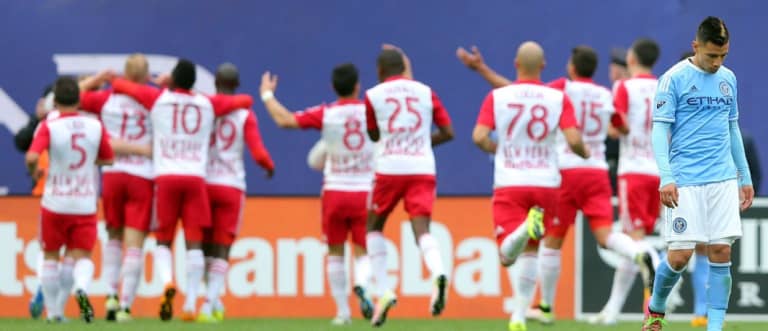HANOVER, N.J. – There was a time just a few years ago that the possession-heavy tiki-taka playing style was all the rage, with clubs like Arsenal and Barcelona and national teams like Spain executing it to aesthetic perfection.
These days, the high press seems to be the strategy that is slowly gaining traction with even with the most high-profile of teams, including the likes of Borussia Dortmund and Jurgen Klopp's Liverpool. The New York Red Bulls are an example of a side in MLS using that method, which was introduced by Jesse Marsch en route to lifting the Supporters’ Shield in his first year in charge of the club in 2015.
Most recently, the Red Bulls rode their high press to one of the most lopsided wins in league history — a 7-0 victory at rivals New York City FC, the team they face again on Sunday in the #NYDerby (12 pm ET; ESPN/ESPN Deportes, MLS LIVE, TICKETS HERE).
The high press, or “counter-pressing,” is a thankless, sometimes grueling way to play, but its results are often breathtaking. The concept takes the idea of defending and moves it into the opponent’s half, where the players at the top of the formation — for the Red Bulls these are Bradley Wright-Phillips, Mike Grella, Lloyd Sam and Sacha Kljestan — do a lot of hard running and harassing of the backline and deep-lying midfielders into mistakes and turnovers, with the hope of converting those into goals.
Against NYCFC back in May, the Red Bulls' press condensed what was already a tight field, forcing the backline into long balls, cutting off service to midfield maestro Andrea Pirlo, and forcing David Villa to play like a target striker. The press systematically dismantled the preferred build-up play strength of Patrick Vieira's squad, showing just how Marsch's press system can take the fluidity out of an opponent's game by creating utter chaos.
It’s the same system, more or less, used by Chile and Argentina to reach this summer's Copa America Centenario final, with hefty defeats posted, respectively, against Mexico (7-0) and the USA (4-0) along the way.
“I think that the fast way of play, whether you want to call it high pressing, whatever you want to call it, is something I think teams find as beneficial,” Marsch said after Red Bulls practice on Tuesday. “The two teams that did it the best in Copa America are Argentina and Chile. They are obviously talented teams as well. But they now emerge in that tournament as the two best. I love watching their style of play; I love looking how they choose to do it, how we choose to do it and the nuances.”

In the case of the Red Bulls, the implementation of the strategy in 2015 represented a drastic change as Marsch took over a veteran team that was transitioning from the Thierry Henry years. In place of a system designed around one player, Marsch brought with him a vision predicated on synchronized team movement, shape and a lot of hard running.
With Henry’s departure, Marsch started with a clean slate in New York and was not shy of bringing about change from Day 1 and “becoming more innovative” in different ways.
“I think we’ve been at the forefront with set pieces,” Marsch noted. “I think we’ve done a lot of unique things and tried some different patterns and ideas to try to free up and create different advantages.”
But the high press also requires a high level of fitness and as recently as last week, Red Bulls left back Connor Lade noted that “training is often harder for us than games.” Last year, Red Bulls players were rhetorically asking one another if they would ever kick a soccer ball again, such was the level of intensity of the fitness component in Marsch’s first preseason with the team.
Reaching peak fitness to implement the high press often takes time, which could help explain a 1-6-0 early-season slump this year and another 2-4-4 rough patch after a hot start in 2015.
But it’s not all about running. There are subtleties to the high press, which will continue to evolve as it becomes a more widespread fixture of the modern game at the highest levels.
“You have first the possession,” Marsch said. “But then when [manager Pep Guardiola] went to Barcelona, then he introduced the counter-pressing style so that when they lost the ball they won it right back. That's something that we do; that’s something I thought Argentina did really well in the [Copa America]. But Argentina also still spaced the field in a really good way, tried to create spacing and match-ups and advantages in certain parts of the field which are tactically a way of trying to unbalance [opposing] teams. The team that does that the best in our league is Columbus. There’s some of that in them.
"All of us that watch the game that are coaches, you’re always just trying to pick on information and little ways that different teams and different coaches do things, and see how it fits into your group.”













